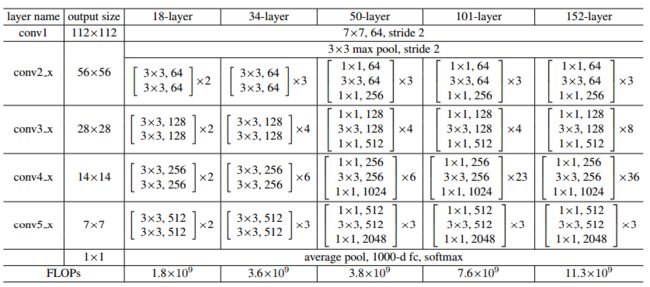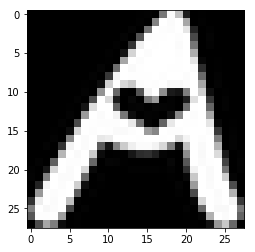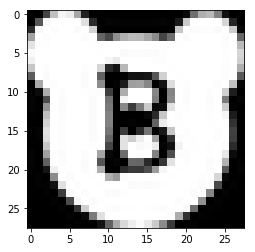卷积神经网络的keras实现
深度残差网络的代码实现
深度残差网络是中微软kaiming he等提出的,在ILSVRC 2015中的classification,detection,localization任务取得了冠军,且在COCO比赛上也夺冠【论文】。在这里对深度残差网络使用keras实现,这里使用的数据集是notmnist,字母A-J,十个字母的识别。(数据集小,渣渣笔记本上运行)
1. 读取数据
import os
import numpy as np
import cv2
import matplotlib.pyplot as plt
import tqdm
train_path='../datasets/notmnist/notMNIST_large/'
test_path='../datasets/notmnist/notMNIST_small/'
img_size=28
num_channels=3
# 读取文件夹图像
def read_letters(folder, size=None):
image_names=os.listdir(folder,)
images=[]
for index, img_name in enumerate(image_names):
if size and index>size-1: break
image=cv2.imread(folder+img_name)
if not image is None:
images.append(image)
return np.array(images)
A=read_letters(train_path+'A/', 100)
print('complete!')
plt.imshow(A[66])
plt.show()
complete!
def concate(x, x_):
if not x is None:
x=np.concatenate([x, x_], axis=0)
else: x=x_
return x
def get_data(train_size=None, test_size=None):
letters=['A', 'B','C','D','E','F','G','H','I','J']
x_train=y_train=x_test=y_test=None
for index, letter in tqdm.tqdm(enumerate(letters)):
x_=read_letters(train_path+letter+'/', train_size)
x_train=concate(x_train, x_)
y_=np.ndarray([x_.shape[0]], dtype=np.uint8)
y_[:]=index
y_train=concate(y_train, y_)
x_=read_letters(test_path+letter+'/', test_size)
x_test=concate(x_test, x_)
y_=np.ndarray([x_.shape[0]], dtype=np.uint8)
y_[:]=index
y_test=concate(y_test, y_)
return x_train, y_train, x_test, y_test
'''for train fast, here i use 1000 training samples per category and 200 test samples'''
x_train, y_train, x_test, y_test = get_data(1000, 200)
print(x_train.shape,y_train.shape)
#from sklearn.model_selection import train_test_split
#train_test_split()
10it [01:26, 8.63s/it]
(10000, 28, 28, 3) (10000,)
# pre process
import keras
y_train=keras.utils.to_categorical(y_train, num_classes=10)
y_test=keras.utils.to_categorical(y_test, num_classes=10)
Using TensorFlow backend.
perm=np.random.permutation(x_train.shape[0])
x_train=x_train[perm]
y_train=y_train[perm]
plt.imshow(x_train[8])
plt.show()
print(y_train[8])
[ 0. 1. 0. 0. 0. 0. 0. 0. 0. 0.]
2. 建立一个简单模型测试
import keras
from keras.models import Sequential, Model
from keras.layers import Conv2D, MaxPooling2D, Flatten, Dense, BatchNormalization, Activation, Input, AveragePooling2D, Add
from keras.optimizers import Adam, rmsprop
from keras.callbacks import EarlyStopping
conv_model=Sequential()
conv_model.add(Conv2D(8, (3, 3), strides=(1, 1), padding='same', activation='relu', input_shape=(img_size, img_size, num_channels)))
conv_model.add(Conv2D(16, (3, 3), strides=(1, 1), padding='same', activation='relu'))
conv_model.add(Conv2D(32, (3, 3), strides=(1, 1), padding='same', activation='relu'))
conv_model.add(MaxPooling2D(pool_size=2))
conv_model.add(Flatten())
conv_model.add(Dense(100, activation='relu'))
conv_model.add(Dense(10, activation='softmax'))
conv_model.compile(optimizer='rmsprop', loss='categorical_crossentropy', metrics=['accuracy'])
early_stopper=EarlyStopping(patience=30)
conv_model.fit(x_train, y_train, validation_data=(x_test, y_test), batch_size=1000, epochs=10, verbose=2, shuffle=True,
callbacks=[early_stopper])
3. 深度卷积网络实现
A building block:  我们的目标是构建这样的块,一共有两种,一种恒等映射,x; 一种非恒等,就是输入和输出的维度不一样,需要对输入进行变换wx。 (identity & projection shortcut)
我们的目标是构建这样的块,一共有两种,一种恒等映射,x; 一种非恒等,就是输入和输出的维度不一样,需要对输入进行变换wx。 (identity & projection shortcut)
(1) identity shorcut
层顺序:conv2d -> BN -> relu,可以是任意层,注意最后一个层要残差链接后再激活函数relu输出
# x:输入,filters:卷积核数,kernelsize:核大小
def identity_shortcut(x, filters, kernel_sizes):
last=x
for i, f in enumerate(filters):
last=Conv2D(f, kernel_sizes[i], strides=(1, 1), padding='same')(last)
last=BatchNormalization()(last)
if i(2) projection shortcut
与identity shortcut不一样的有两点:
- projection中的第一层可能需要做downsampling,即stride为2
- 最后一层残差连接,因为维度不一样,要对输入做投射到相同维度;因为经过第一层的downsampling,feature map 边大小减半。所以连接时对x(输入)做卷积操作,步数为2,核大小1,核数等于最后一层核数。
(详细在代码或论文中展示
def projection_shortcut(x, filters, kernel_sizes, strides=(2, 2), proj_strides=(2, 2)):
last=x
for i, f in enumerate(filters):
if i==0: last=Conv2D(f, kernel_sizes[i], strides=strides, padding='same')(last)
else: last=Conv2D(f, kernel_sizes[i], strides=(1, 1), padding='same')(last)
last=BatchNormalization()(last)
if ips: 这里犯了个错误,因为对keras算刚接触不久,后面的model代码报错:'Tensor' object has no attribute '_keras_history' ,最后发现是+法的错,在keras中不能直接相加,应该是keras中应该需要记录(_keras_history), 所以不支持直接相加,减法,乘法等) https://stackoverflow.com/questions/45030966/attributeerrortensor-object-has-no-attribute-keras-history 中:
The problem lied in the fact that using every tf operation should be encapsulated by either:
- Using keras.backend functions,
- Lambda layers,
- Designated keras functions with the same behavior.
When you are using tf operation - you are getting tf tensor object which doesn't have history field. When you use keras functions you will get keras.tensors.
所以是因为+操作返回了tensorflow的tensor,从而没有history field。
(3) model details
论文中网络有5个,分别为18,34,50,101和152层,具体如下表(表中后三个网络的第一个卷积层核数为256):  有了两个函数后就只需跟着表建立即可,用到projection shortcut的是conv3_1, conv4_1, conv5_1。 下面将实现50-layer:
有了两个函数后就只需跟着表建立即可,用到projection shortcut的是conv3_1, conv4_1, conv5_1。 下面将实现50-layer:
inp=Input(shape=(img_size, img_size, num_channels))
# out=Flatten()(inp)
# print(out.shape)
# model=Model(inputs=inp, outputs=out)
out=Conv2D(256, 7, strides=2, padding='same')(inp)
print(out.shape)
out=BatchNormalization()(out)
out=Activation('relu')(out)
out=MaxPooling2D(pool_size=(3, 3), strides=2, padding='same')(out)
print(out.shape)
out=identity_shortcut(out, [64, 64, 256], [1, 3, 1])
out=identity_shortcut(out, [64, 64, 256], [1, 3, 1])
out=identity_shortcut(out, [64, 64, 256], [1, 3, 1])
out=projection_shortcut(out, [128, 128, 512], [1, 3, 1])
out=identity_shortcut(out, [128, 128, 512], [1, 3, 1])
out=identity_shortcut(out, [128, 128, 512], [1, 3, 1])
out=identity_shortcut(out, [128, 128, 512], [1, 3, 1])
out=projection_shortcut(out, [256, 256, 1024], [1, 3, 1])
out=identity_shortcut(out, [256, 256, 1024], [1, 3, 1])
out=identity_shortcut(out, [256, 256, 1024], [1, 3, 1])
out=identity_shortcut(out, [256, 256, 1024], [1, 3, 1])
out=identity_shortcut(out, [256, 256, 1024], [1, 3, 1])
out=identity_shortcut(out, [256, 256, 1024], [1, 3, 1])
out=projection_shortcut(out, [512, 512, 2048], [1, 3, 1])
out=identity_shortcut(out, [512, 512, 2048], [1, 3, 1])
out=identity_shortcut(out, [512, 512, 2048], [1, 3, 1])
out=AveragePooling2D(padding='same')(out)
out=Flatten()(out)
print(out.shape)
out=Dense(10, activation='softmax')(out)
model=Model(inputs=inp, outputs=out)
(?, 14, 14, 256)
(?, 7, 7, 256)
(?, ?)
model.compile(optimizer='rmsprop', loss='categorical_crossentropy', metrics=['accuracy'])
early_stopper=EarlyStopping(patience=10)
model.fit(x_train, y_train, validation_data=(x_test, y_test), batch_size=1000, epochs=100, verbose=2, shuffle=True,
callbacks=[early_stopper])
Train on 10000 samples, validate on 2000 samples
Epoch 1/100
- 1561s - loss: 3.4706 - acc: 0.1152 - val_loss: 4.4505 - val_acc: 0.1410
Epoch 2/100
至此,深度卷积神经网络的框架就实现了,不过论文中的数据增强,crops,ensemble等就没有去做实现。
(my gitbub: https://github.com/xiaoqinzhe/blog/tree/master/paper/image_recognization/deep_residual_network#深度残差网络的代码实现)

